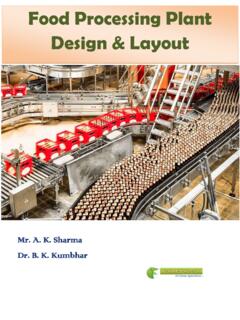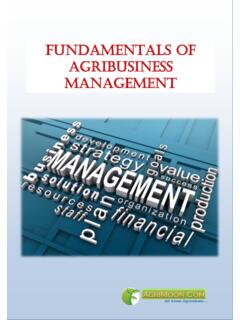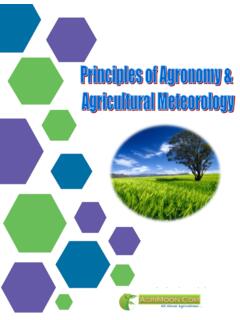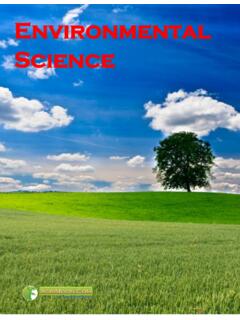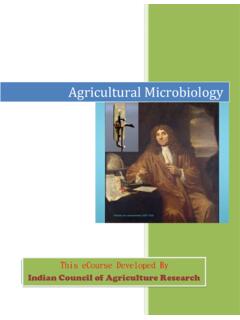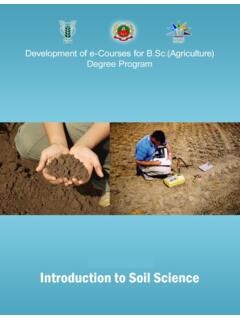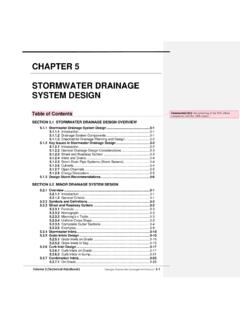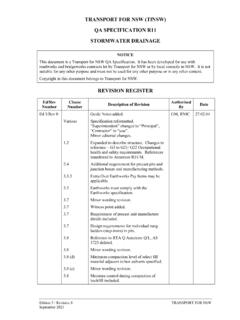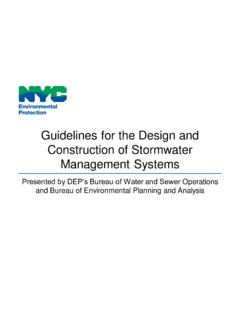Transcription of Drainage Engineering - AgriMoon
1 Drainage Engineering Dr. M K Jha Prof. K Yellareddy Drainage Engineering -: Course Content Developed By:- Dr. M K Jha Professor Dept. of Agricultural and Food Engg., IIT Kharagpur -: Content Reviewed by :- Prof. K Yellareddy Director (A&R). Walamtari, Rajendranagar, Hyderabad Index Lesson Page No Module 1: Basics of Agricultural Drainage Lesson 1 Introduction to Land Drainage 5-12. Lesson 2 Land Drainage Systems 13-15. Module 2: Surface and Subsurface Drainage Systems Lesson 3 Design of Surface Drainage Systems 16-33. Lesson 4 Design of Subsurface Drainage Systems 34-48. Lesson 5 Investigation of Drainage Design Parameters 49-64. Module 3: Subsurface Flow to Drains and Drainage Equations Lesson 6 Steady-State Flow to Drains 65-83. Lesson 7 Unsteady-State Flow to Drains 84-95.
2 Lesson 8 Special Drainage Situations 96-104. Module 4: Construction of Pipe Drainage Systems Lesson 9 Materials for Pipe Drainage Systems 105-111. Lesson 10 Layout and Installation of Pipe Drains 112-119. Module 5: Drainage for Salt Control Lesson 11 Drainage of Irrigated, Humid and Coastal 120-130. Regions Lesson 12 Vertical Drainage and Biodrainage Systems 131-138. Lesson 13 Salt Balance of Irrigated Land 139-149. Lesson 14 Reclamation of Chemically Degraded Soils 150-163. Lesson 15 Salient Case Studies on Drainage and Salt 164-186. Management Module 6: Economics of Drainage Lesson 16 Economic Evaluation of Drainage Projects 187-193. ** **. This Book Download From e-course of ICAR. Visit for Other Agriculture books, News, Recruitment, Information, and Events at Give FeedBack & Suggestion at Send a Massage for daily Update of Agriculture on WhatsApp +91-7900 900 676.
3 Disclaimer: The information on this website does not warrant or assume any legal liability or responsibility for the accuracy, completeness or usefulness of the courseware contents. The contents are provided free for noncommercial purpose such as teaching, training, research, extension and self learning. ** **. Connect With Us: Drainage Engineering Module 1: Basics of Agricultural Drainage Lesson 1 Introduction to Land Drainage What is Drainage ? Irrigation and Drainage constitutes a subset of water resources system and are crucial for human survival Land Drainage , or the combination of irrigation and land Drainage , is one of the most important input factors to maintain or improve agricultural productivity. To enlarge the present cultivated area, more land must be reclaimed than the land that is lost due to urban/industrial development, roads and land degradation.
4 However, in some areas, land is a limiting resource, whereas in other areas, agriculture cannot expand at the cost of nature. Drainage is a reverse process of irrigation. It is broadly defined as the removal (disposal) of excess water from a land (usually agricultural land). The terms Drainage , land Drainage , agricultural Drainage and field Drainage are used as synonyms in practice. Since Drainage (land Drainage ) is necessary not only for the removal of excess surface water or groundwater but also for removing salts from the soil, a precise definition of Drainage has been given by the constitution of the International Commission on Irrigation and Drainage (ICID, 1979). According to ICID (1979), land Drainage is defined as follows: Land Drainage is the removal of excess surface and subsurface water from the land to enhance crop growth, including the removal of soluble salts from the soil.
5 The above definition of land Drainage (or Drainage ) is well known and is used worldwide. Objectives of Drainage Plant roots require a favorable environment to extract water and nutrient solutions to meet the plant s requirement. For most crops, soil moisture ranging from field capacity to 50% of the field capacity in the root zone is considered ideal. Only a few crops such as rice and jute need standing water on the field at certain stages of their growth. Chemically, a neutral and non-saline soil is ideal for proper growth and yield of most food crops. Excess water and/or high salt concentration in the root zone or at the land surface do not allow the plant roots to function normally. As a result, the plant growth and yield are adversely affected. In the extreme cases of water logging and salinity, the seeds may not germinate and the plants may wilt permanently.
6 The result is a loss of agricultural production. Land Drainage , as a tool to manage excess surface water and groundwater levels, plays an important role in maintaining and improving crop yields: Drainage prevents a decrease in the productivity of arable land due to rising water tables and the accumulation of salts in the root zone. Drainage is the only way to reclaim the land which is not cultivated due to water logging and salinity problems. 5. Drainage Engineering Agricultural land Drainage in essence is both a preventive and a curative measure for the prevention of physical and chemical degradation of soils and for the reclamation of already degraded lands. Thus, Drainage of agricultural lands is an effective technique to maintain a sustainable agricultural system as well as to avoid environmental damage.
7 Drainage Problems in India Water logging and salt accumulation are major constraints to sustainable agricultural production in most countries of the world, especially in developing countries (including India). In India, Drainage problem is acute in the states of Punjab and Haryana, while it also prevails in the command areas of other states. Broadly speaking, water logging is a situation of an agricultural land when the root zone gets saturated. Such a condition restricts normal air circulation, reduces the oxygen level and increases carbon dioxide level in the root zone. On the other hand, salt affected soils are those in which the concentration of salts in the root zone adversely affects the normal root activity. Both the water logging and salt affected soils produce detrimental effects on crop growth and yield as well as cause environmental degradation.
8 Water logging and salinity of agricultural lands are caused due to natural causes or artificial causes ( , human interventions). Important natural causes are high rainfall during the rainy season, unfavourable topography, backwater entry from rivers, seawater intrusion, high evaporation during long dry periods, and the salts present in the soil. On the contrary, important human factors are unscientific management of land and irrigation water, use of poor-quality water for irrigation, adoption of unscientific and non-sustainable cropping pattern, and obstruction of natural outlets because of urbanization and construction of highways and railways. Definition, Classification and Impact of Water logging (1) What is Water logging? Generally, the term water logging refers to the condition of a land (soil) in which the water table comes within or very near the root zone due to which crop yields decrease below the normal yield or the land cannot be used for cultivation.
9 The soil becomes waterlogged when the water fills up all the pore space present in the soil profile, and it remains waterlogged when Drainage facility is inadequate or absent. This type of water logging is quite common in irrigated agricultural lands and is known as subsurface water logging or simply water logging . According to FAO (FAO, 1973), waterlogged areas are those where soils are temporarily saturated or where the water table is too shallow such that capillary rise of groundwater encroaches upon the root zone and may even reach the soil surface. Moreover, water logging also occurs when water is stagnant on the land surface for considerable time due to absence of a proper outlet and insignificant infiltration. This type of water logging is known as surface water logging.
10 (2) Classification of Water logging The working group on problem identification in Irrigated Areas, constituted by the Ministry of Water Resources, Government of India (MOWR, 1991) adopted the following norms for the identification of waterlogged areas: 6. Drainage Engineering (i) Waterlogged Area: Water table within 2 m from the land surface. (ii) Potential Area for Water logging: Water table between 2-3 m from the land surface. (iii) Safe Area: Water table below 3 m from the land surface. The above categorization does not consider the time of the year or type cropping season in relation to the water table depths and runoff accumulation over the crop land. Crops vary greatly in their rooting depth and susceptibility to water logging. The dry season crops are more susceptibility to water logging than the wet season crops.
